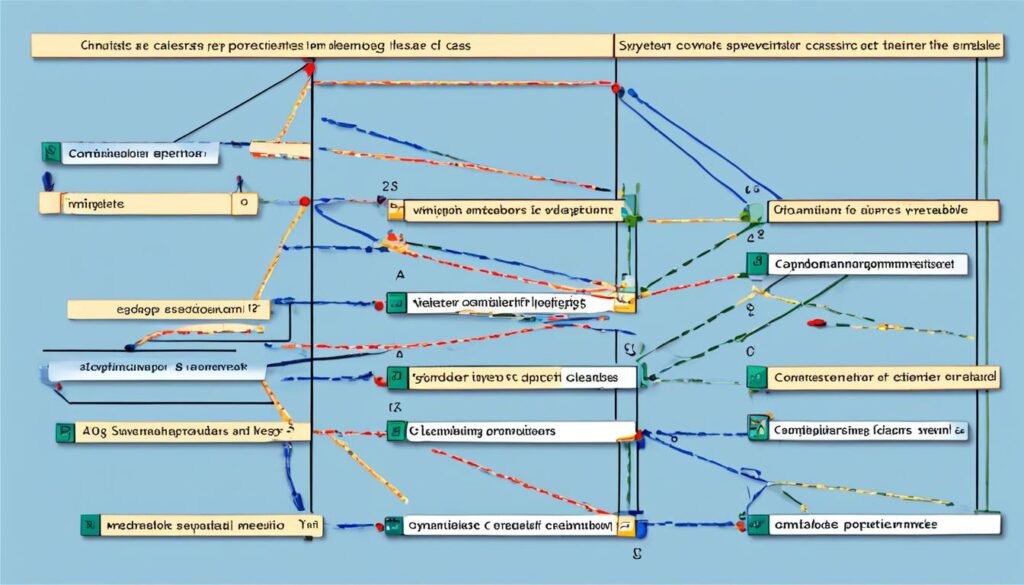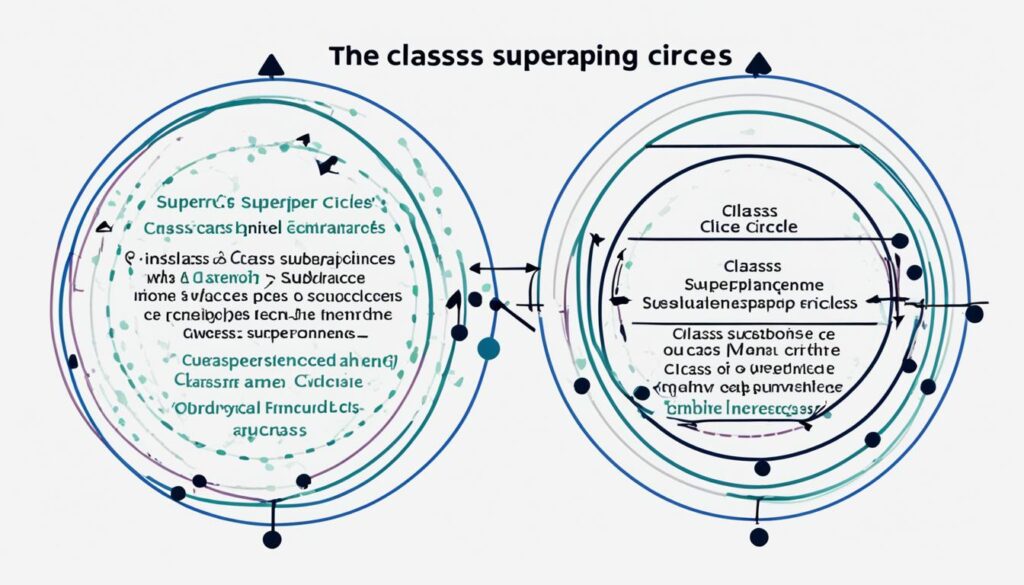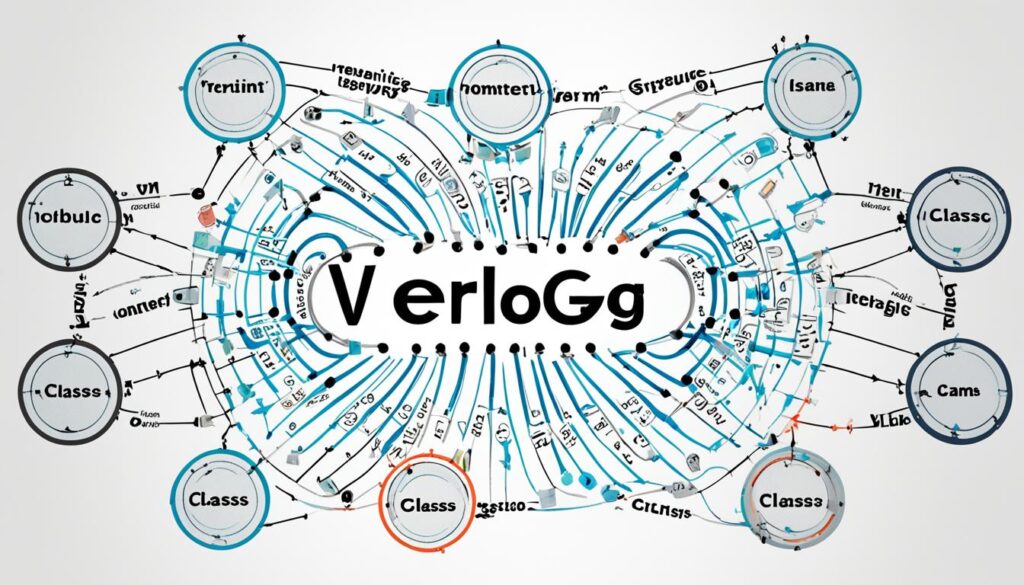Welcome to our comprehensive guide on Classes and Objects in System Verilog. As a powerful hardware modeling and simulation language, System Verilog offers designers a wide range of tools and concepts to create robust hardware systems. Among these tools, Classes and Objects play a crucial role in designing efficient and scalable hardware models.
Throughout this article, we will explore the fundamentals of Classes and Objects, their usage, and the benefits they bring to the hardware design process. By understanding how Classes provide a blueprint for defining objects and encapsulating their properties and behaviors, designers can create modular and reusable code.
Through the creation of Objects, we can manipulate their properties and invoke their methods, allowing for dynamic and interactive hardware modeling. Additionally, we will delve into advanced techniques, such as inheritance and polymorphism, that enable objects to exhibit different behaviors based on their context.
By following best practices and applying these concepts, designers can create efficient and scalable hardware models that can be easily maintained and modified. So, let’s dive into this exciting world of Classes and Objects in System Verilog and unlock the full potential of hardware design.
Table of Contents
Understanding Classes in System Verilog
In this section, we will delve into the concept of Classes in System Verilog. Classes are a fundamental feature of System Verilog that enable the creation of objects and encapsulation of their properties and behaviors. They serve as blueprints for defining and organizing the structure and functionality of objects in hardware modeling.
Syntax of Classes
Classes in System Verilog are defined using the class keyword, followed by the class name. Class names usually start with an uppercase letter and follow a naming convention that reflects their purpose or functionality. Inside a class, you can define member variables, member functions, and static members that encapsulate the data and behavior of the objects instantiated from the class.
Instantiating Classes
To create objects from a class, you can use the new keyword followed by the class name and optional constructor arguments. The constructor is a special member function that is automatically called when an object is created. It initializes the object’s member variables and sets its initial state. Multiple objects can be instantiated from the same class, each with its own unique set of properties and behaviors.
Usage of Classes in Hardware Modeling
Classes in System Verilog are widely used in hardware modeling to represent different components of a design and their interactions. They provide a modular and organized approach to modeling complex systems. By encapsulating properties and behaviors within classes, designers can easily manage and manipulate objects in their hardware models. Classes also facilitate code reuse, as they can be instantiated in multiple instances and easily modified to fit specific design requirements.
In System Verilog, classes play a crucial role in creating scalable and efficient hardware models. They enhance the readability, maintainability, and reusability of code, allowing designers to build robust and complex systems with ease. Understanding the syntax, instantiation, and usage of classes is essential for any hardware designer working in System Verilog.
| Advantages of Classes in System Verilog | Disadvantages of Classes in System Verilog |
|---|---|
|
|
Despite some challenges, leveraging the power of classes in System Verilog can greatly benefit hardware designers, enabling them to create robust and efficient hardware models that meet the demands of modern technology.
Objects and Instances in System Verilog
In System Verilog, objects and instances play a crucial role in designing complex and scalable hardware systems. By creating objects from classes, we can encapsulate properties and behaviors to represent specific entities within our design.
An object is an instance of a class. It is a tangible representation of a blueprint defined by the class that defines its structure and behavior. Objects allow us to manipulate properties and invoke methods, enabling us to model and simulate hardware systems effectively.
To create an object, we use the instantiation process, where we allocate memory and initialize it with the desired values. With the object in hand, we can access its properties and invoke its methods to perform specific actions. This allows us to build sophisticated hardware models by combining multiple objects with different characteristics.
Understanding Classes and Objects
Let’s take an example to better understand the relationship between classes and objects. Consider a class named “Car,” which defines the structure and behavior of a car.
Using the Car class as a blueprint, we can create multiple objects representing different cars. Each object will have its own set of properties, such as color, model, and speed, and can perform specific actions, such as accelerating and braking.
By manipulating the properties and invoking methods on each instance, we can simulate real-world scenarios and behavior in our hardware models, making them more accurate and reliable.
Inheritance and Polymorphism
System Verilog also supports inheritance and polymorphism, allowing us to create hierarchies of classes and objects with shared properties and behaviors.
Through inheritance, a child class can inherit properties and methods from its parent class, reducing redundancy and promoting code reuse. This enables us to build complex hierarchies of related classes, enhancing the modularity and scalability of our hardware models.
Polymorphism allows objects to exhibit multiple forms or behaviors based on their context. It enables us to treat objects of different classes in a unified manner, simplifying our code and enhancing its flexibility.
Example Table
| Class | Description |
|---|---|
| Car | Represents a car with properties like color, model, and speed. |
| Truck | Derived from the Car class, represents a larger vehicle with additional properties like weight and cargo capacity. |
| Motorcycle | Derived from the Car class, represents a two-wheeled vehicle with its own set of properties like engine displacement and number of cylinders. |
Integrating objects and instances into our System Verilog designs allows us to create modular, reusable, and scalable hardware models. By understanding their concepts and leveraging inheritance and polymorphism, we can develop sophisticated simulations that accurately represent real-world systems.
Class Methods and Members in System Verilog
When working with classes in System Verilog, it is important to understand the various types of methods and members that can be defined within a class. These methods and members play a crucial role in defining the behavior and properties of objects created from the class.
Class Members
Class members are variables and constants that are declared within a class. They represent the properties of the objects created from the class. There are two types of class members: static and non-static.
Static members are shared among all objects created from the class. They are declared using the static keyword and can be accessed without creating an instance of the class. Static members are useful for storing information that is common to all objects of the class.
Non-static members, on the other hand, are specific to each individual object created from the class. They are declared without the static keyword and can only be accessed through an instance of the class. Non-static members represent the unique characteristics of each object.
Class Methods
Class methods are functions that are defined within a class. They define the behavior and actions that objects created from the class can perform. Like class members, class methods can also be classified as static or non-static.
Static methods are associated with the class itself rather than any particular object. They are declared using the static keyword and can be invoked without creating an instance of the class. Static methods can only access static members and cannot access non-static members.
Non-static methods, also known as instance methods, are associated with individual objects created from the class. They are declared without the static keyword and can only be invoked through an instance of the class. Non-static methods can access both static and non-static members of the class.
Constructors and Destructors
In addition to class members and methods, classes in System Verilog can also have special methods known as constructors and destructors.
A constructor is a special method that is automatically invoked when an object is created from the class. It is used to initialize the object and set its initial state. Constructors have the same name as the class and do not have a return type.
A destructor, on the other hand, is a special method that is automatically invoked when an object is destroyed or goes out of scope. It is used to perform any necessary clean-up operations before the object is deallocated from memory. Destructors have the same name as the class preceded by a tilde (~) symbol and do not have a return type.
Here is an example demonstrating the usage of constructors and destructors in System Verilog:
“`systemverilog
class Rectangle;
int width, height;
function new(int w, int h);
width = w;
height = h;
endfunction
function void delete();
$display(“Deleting Rectangle object”);
endfunction
endclass
“`
As shown in the example above, the constructor new() is used to initialize the width and height members of the class. The destructor delete() is used to display a message when the Rectangle object is destroyed.
A Comparison between Static and Non-Static Class Members
To summarize the differences between static and non-static class members:
| Static Members | Non-Static Members |
|---|---|
| Shared among all objects of the class | Specific to each object of the class |
Declared using the static keyword |
Declared without the static keyword |
| Can be accessed without creating an instance of the class | Can only be accessed through an instance of the class |
Understanding class methods and members in System Verilog is crucial for creating well-designed and efficient hardware models. The careful usage of static and non-static members, along with constructors and destructors, enables the creation of flexible and modular hardware designs.

Class Inheritance and Polymorphism in System Verilog
In this section, we will dive deeper into the concepts of class inheritance and polymorphism in System Verilog. Understanding these fundamental principles is crucial for designing efficient and flexible hardware systems.
Class Inheritance
Class inheritance is a powerful feature in System Verilog that allows classes to inherit properties and behaviors from parent classes. By extending existing classes, designers can efficiently reuse code and build hierarchical relationships among classes.
With class inheritance, a subclass (also known as a derived class) inherits all the member variables and methods of its parent class (also known as a base class). This allows for the reuse of existing code and promotes modularity and code organization.
Polymorphism
Polymorphism is another essential concept in System Verilog that enables objects to exhibit different forms and behaviors based on their context. It allows for more flexible and adaptable code, enhancing code reusability and enhancing the overall design.
With polymorphism, different objects can be treated as instances of their parent class or as instances of their own class. This flexibility enables objects to respond differently to the same method call, depending on their specific implementation.

Benefits of Class Inheritance and Polymorphism
Class inheritance and polymorphism offer several benefits in System Verilog:
- Code Reusability: The ability to reuse existing code through inheritance and polymorphism helps streamline development and reduce redundancy.
- Modularity: Inheritance allows for the creation of modular code structures, making it easier to manage and maintain complex hardware designs.
- Flexibility: Polymorphism enables objects to behave differently based on their specific implementation, enhancing adaptability and flexibility.
- Scalability: With class inheritance, designers can easily extend existing classes and add new functionality, making it easier to scale and modify hardware designs.
By leveraging class inheritance and polymorphism, designers can build robust and scalable hardware systems in System Verilog. In the next section, we will explore advanced techniques and best practices for working with classes and objects.
Advanced Techniques and Best Practices with Classes and Objects
When working with Classes and Objects in System Verilog, it is essential to employ advanced techniques and adhere to best practices. These approaches enable us to design efficient and scalable hardware models while promoting code reusability and maintainability.
Encapsulation
One of the core principles in Object-Oriented Programming is encapsulation. By encapsulating data and methods within a class, we create a clear separation between the internal implementation and external usage. This promotes code organization, improves readability, and minimizes dependencies between different parts of the codebase.
Data Hiding
Data hiding, also known as information hiding, is a crucial aspect of designing robust classes. It involves restricting direct access to the internal data of a class by using access modifiers such as public, private, and protected. By exposing only the necessary interfaces and hiding the implementation details, we ensure data integrity and prevent unintended modifications.
Access Modifiers
System Verilog provides access modifiers such as public, private, and protected, which allow us to control the visibility and accessibility of class members. By carefully selecting the appropriate access modifiers, we can define which parts of the class are accessible from outside code and which are restricted to the class itself or its derived classes.
Design Considerations
When designing hardware models using Classes and Objects, it is important to consider scalability and efficiency. Here are some best practices to keep in mind:
- Use inheritance wisely: Inheritance can be a powerful tool for code reuse, but it should be used judiciously. Evaluate whether a particular scenario truly requires inheritance or if composition would be a better approach.
- Avoid excessive nesting: Deeply nested class hierarchies can lead to complex and convoluted code. Strive for simplicity and clarity by favoring shallow class hierarchies.
- Minimize memory usage: Optimize memory consumption by carefully managing the size and lifetime of objects. Avoid unnecessary duplication of data and release resources when they are no longer needed.
- Follow naming conventions: Consistent and descriptive naming conventions make the code more intuitive and easier to understand. Use meaningful names for classes, methods, and variables to enhance readability.
By incorporating these advanced techniques and following best practices, we can ensure the development of efficient, maintainable, and scalable hardware models using Classes and Objects in System Verilog.
| Advanced Techniques | Best Practices |
|---|---|
| Encapsulation | Follow naming conventions |
| Data Hiding | Use inheritance wisely |
| Access Modifiers | Avoid excessive nesting |
| Design Considerations | Minimize memory usage |
Conclusion
In conclusion, Classes and Objects play a crucial role in the development of robust hardware systems using System Verilog. By understanding the concepts and utilizing them effectively, designers can create modular, reusable, and scalable hardware models. Classes serve as blueprints for defining objects and encapsulating their properties and behaviors, while objects allow manipulation and invocation of these entities.
Throughout this article, we have explored the fundamentals of Classes and Objects, including their syntax, instantiation, and usage in hardware modeling. We have also delved into advanced techniques such as inheritance and polymorphism, which enable designers to create flexible and adaptable hardware models. Additionally, we have discussed best practices such as encapsulation, data hiding, and access modifiers to ensure efficient and scalable designs.
By mastering the concepts and techniques presented in this article, designers can enhance their skills in hardware modeling and simulation, leading to the development of high-quality hardware systems. We hope this article has provided valuable insights into the essentials of Classes and Objects and their role in hardware design. Happy modeling!

